
- Address : P.O. Box 11, Gannoruwa rd, Peradeniya, Sri Lanka
- E- Mail : director.hordi@doa.gov.lk
- Telephone :(+94) 081-2388011-12-13
- Fax :(+94) 081-2388234
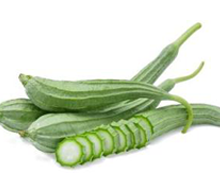
Luffa
Luffa acutangula
Ridge gourd/ sponge gourd (Wetakolu) is a very popular crop belonging to family Cucurbitaceae
It can be cultivated in all over the low country, mid, country wet zone and Intermediate Zones, as an economical crops
Released Varieties
Climatic requirements/ Areas suitable for cultivation
Crop can be grown successful in hot weather. Can be cultivated up to 500m from sea level.
Wet zone – Can be cultivated throughout the year
Dry Zone – Mainly cultivated in Maha Season, can be cultivated successfully under irrigation in Yala season
Soil
Well-Draining, sandy loam soil with organic matter is ideal for cultivation. Soil pH should be around 5.5 -7.5 for optimal growth
Seed requirement
3 kg /ha
Land preparation
Harrow the soil and break the soil finely and mark pits to recommended spacing. Make several deep drains to avoid excess water retention in field.
Planting
Soak the seeds in water for about 24 hours. Plant about 3-4 seeds per pit, fairly away from each other. Keep the seeds well watered.
Spacing
Between rows and between plants within the row – 1.5 m (1.5 m x 1.5 m)
Fertilizer
Add 10 t/ha of well decomposed organic matter. Additionally apply chemical fertilizers as recommended. Apply basal fertilizers 2-3 days before planting
Time of Application | Urea kg/ha | TSP kg/ha | MOP kg/ha |
Basal | 75 | 195 | 60 |
Top Dressing One (4weeks after planting) | 75 | – | 60 |
Top Dressing One (8 weeks after planting) | 75 | – | 60 |
Water supply / Irrigation
Irrigate twice a day until seeds are germinated. After that irrigation should be practiced according to moisture condition in the soil.
Weed Control
Has a shallow root system. Therefore, when controlling weeds, be careful not to damage the root systems of luffa vines
Harvesting
Irrigate previous day evening before harvesting. Harvesting can be done around 14 days after flowering. Harvest with the stalk as not to damage the fruit. First harvesting can be taken around 60-70 days after planting. 10-15 harvesting can be done over a period of 1 ½ – 2 months with 4 days interval of harvesting.
Processing of Yield
Avoid direct sunlight on harvested fruits pack in baskets to ensure good ventilation so as not to damage the fruit
Thinning out
After 2 weeks of seedling emergence leave two healthy plants and remove the rest.
Training
For good results vines should be trained in trellises about 2m high
For this setup the trellises vertically or horizontally with ropes or wire, Set up strong poles to a spacing of about 3m.
Remove side vines/ water sprouts from the main stem to avoid coming up to the trellis
Pest Management
Disease Management
- Fungal diseases
- First appears as pale yellow spots on older leaves
- These spots enlarge as the white, fluffy mycelium grows over leaves surfaces
- Severely attacked leaves become brown and shrivelled and defoliation may occur
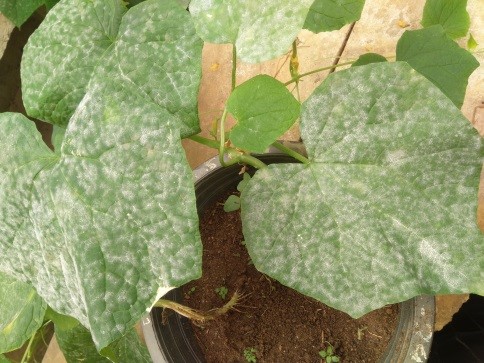 |
- Use recommended fungicides at initial stage of disease development (Refer: Pesticide recommendation DOA, 2019)
- Distraction of infected plant debris after harvest
Causal organism: Pseudoperonospora cubensis
Symptoms:
- Angular yellow spots that are limited by the leaf veins on the upper surface of the leaves.
- Leaves become chlorotic and finally necrotic and host plant cells die
Management:
- Use recommended fungicides at initial stage of disease development (Refer: Pesticide recommendation DOA, 2019)
- Distraction of infected plant debris after harvest
Causal organisms: Sclerotium spp., Fusarium spp.
Symptoms:
- Initially the plants show temporary wilting symptoms
- The leaves yellowing, loose turgidity and show drooping
- Eventually, the plant dies.
- Vascular bundles in the collar region become yellow or brown.
Management:
- Destroy infected plants with soil
- Improved drainage
- Use recommended fungicides at initial stage of disease development (Refer: Pesticide recommendation DOA, 2019)
Causal organisms: Didymella bryoniae
Symptoms:
- Lesions on leaves and fruit usually begin as spreading water-soaked areas
- The former these may have a chlorotic halo, become light brown and irregular in outline
- Dark cracked sunken lesions on fruit
- Plant collapse where sunken, girdling cankers
- Spots on stems often elongate into streaks and gummy exudates may occur from cracks
- Dark brown to black fruiting bodies (pycnidia) can be seen on fruit, stem, or leaf
Management:
- Crop debris should be ploughed deeply immediately after harvest to reduce fungus survival
- Use recommended fungicides at initial stage of disease development (Refer: Pesticide recommendation DOA, 2019)
- Bacterial diseases
- Sudden drooping of leaves
- Whole plant finally wilts
- Leaves become brown, dry
- Vascular discoloration (Brown)
- Permanent wilting
- Infected soil, water, plant debris, Nematodes and insects ,pruning, Weeds as host plants
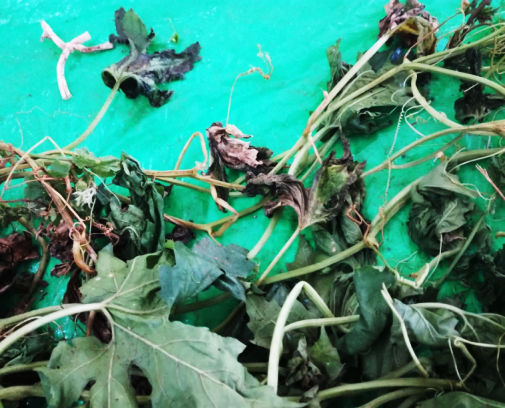 |
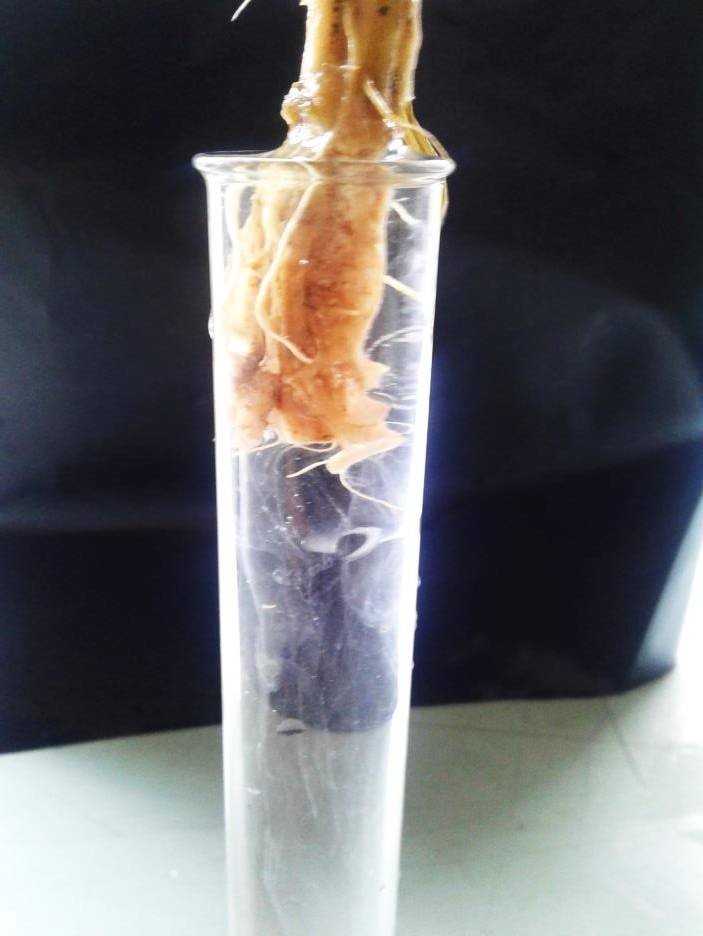 |
- Destroy infected plants with soil
- Crop rotation with non- susceptible crops (okra , maize)
- Mixed cropping with cruciferae crops
- Avoid movement of equipment from infected fields to non- infected fields
- Viral diseases
- upward curling, shortening, and distortion of leaves
- Plant stunted and fruits deformed.
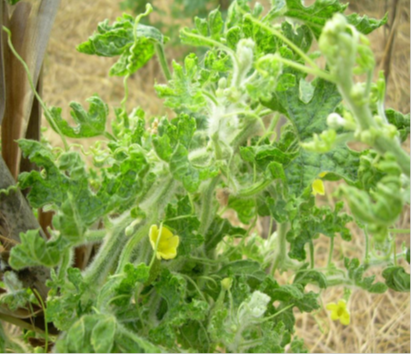 |
- Mosaic and mottling of leaves
- leaf distortion
- Malformation of fruits and reduction in fruit size
- In severe infections, oily patches on the fruit surface
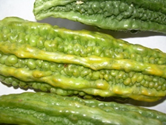 |
Transmission: Seed borne, through sap
Symptoms:
- Green mottle, leaf deformation
- Green spot on fruits, turn bright yellow and decaying fruit
- fruit malformation.
Symptoms:
- Stunting, yellowing, necrosis (occasionally), mosaic, leaf deformations (blisters, shoe stringing)
- Fruit discolorations and deformations
- Pytoplasma Disease
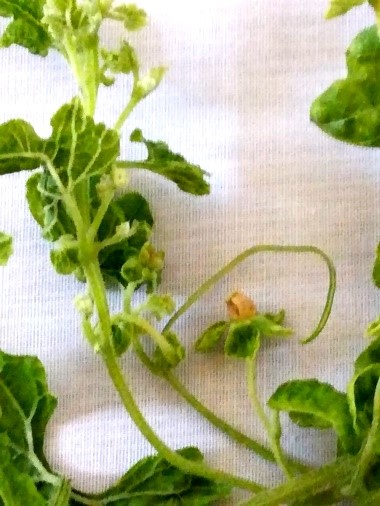 |
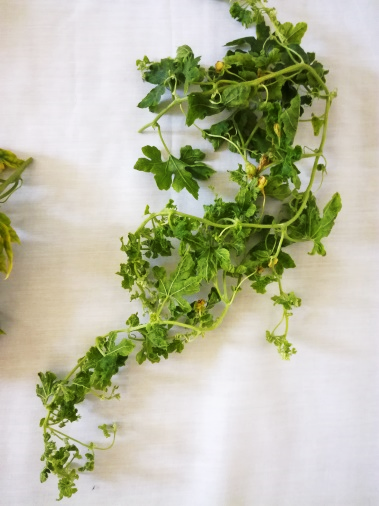 |

